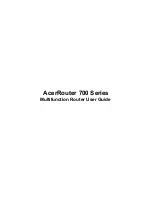
7
WIRELESS PERFORMANCE CONSIDERATIONS
There are a number of factors that can impact the range of wireless devices.
1. Adjust your wireless devices so that the signal is traveling in a straight path, rather than at an angle.
The more material the signal has to pass through the more signal you will lose.
2. Keep the number of obstructions to a minimum. Each obstruction can reduce the range of a wireless
device. Position the wireless devices in a manner that will minimize the amount of obstructions
between them.
3. Building materials can have a large impact on your wireless signal. In an indoor environment, try to
position the wireless devices so that the signal passes through less dense material such as dry wall.
Dense materials like metal, solid wood, glass or even furniture may block or degrade the signal.
4. Antenna orientation can also have a large impact on your wireless signal. Use the wireless adapter’s site
survey tool to determine the best antenna orientation for your wireless devices.
5. Interference from devices that produce RF (radio frequency) noise can also impact your signal. Position
your wireless devices away from anything that generates RF noise, such as microwaves, radios and
baby monitors.
6. Any device operating on the 2.4GHz frequency will cause interference. Devices such as 2.4GHz
cordless phones or other wireless remotes operating on the 2.4GHz frequency can potentially drop the
wireless signal. Although the phone may not be in use, the base can still transmit wireless signal.
Move the phone’s base station as far away as possible from your wireless devices.
If you are still experiencing low or no signal consider repositioning the wireless devices or installing
additional access points. The use of higher gain antennas may also provide the necessary coverage
depending on the environment.
limit the range. Typical ranges vary depending on the types of materials and background RF (radio
frequency) noise in your home or business. The key to maximizing wireless range is to follow these basic
guidelines:
1 Keep the number of walls and ceilings between the TEW-639GR and other network devices to a
minimum - each wall or ceiling can reduce your wireless products range from 3-90 feet (1-30 meters.)
Position your devices so that the number of walls or ceilings is minimized.
2 Be aware of the direct line between network devices. A wall that is 1.5 feet thick (.5 meters), at a
45-degree angle appears to be almost 3 feet (1 meter) thick. At a 2-degree angle it looks over 42 feet
(14 meters) thick! Position devices so that the signal will travel straight through a wall or ceiling (instead
of at an angle) for better reception.
3 Building Materials can impede the wireless signal - a solid metal door or aluminum studs may have a
negative effect on range. Try to position wireless devices and computers with wireless adapters so that
the signal passes through drywall or open doorways and not other materials.
4 Keep your product away (at least 3-6 feet or 1-2 meters) from electrical devices or appliances that
generate extreme RF noise.
Summary of Contents for TEV-639GR
Page 1: ...1 ...
Page 34: ...34 Help Help section provides web based explanations on each configurable field ...
Page 41: ...41 ...








































